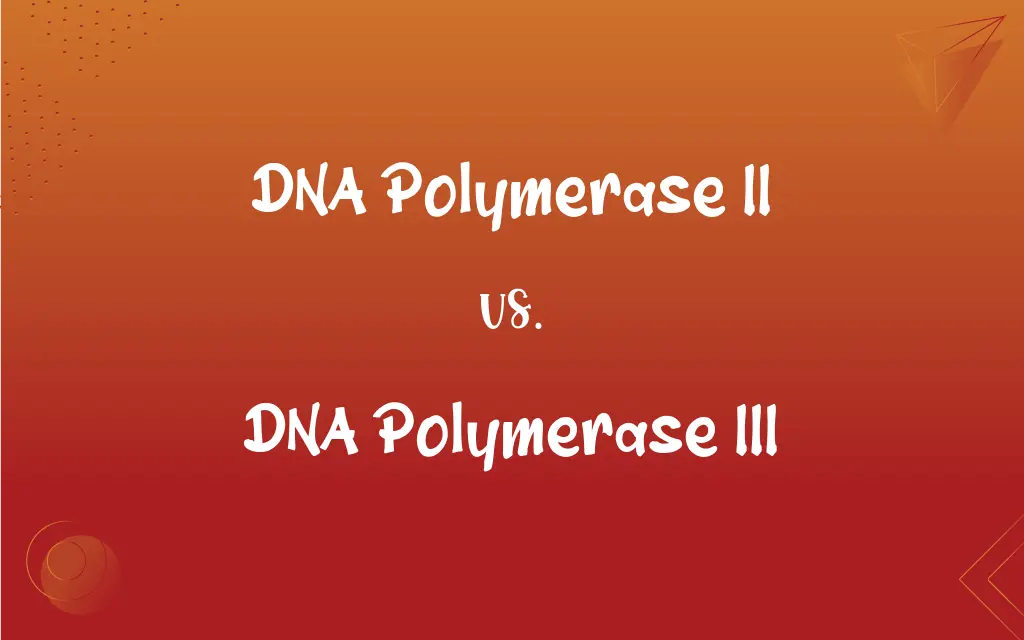DNA Polymerase II vs. DNA Polymerase III: What's the Difference?
Edited by Aimie Carlson || By Janet White || Published on February 13, 2024
DNA Polymerase II functions in DNA repair, while DNA Polymerase III is the primary enzyme responsible for DNA replication in bacteria.

Key Differences
DNA Polymerase II, found in bacteria, primarily plays a role in DNA repair processes. In contrast, DNA Polymerase III, also in bacteria, is the key enzyme responsible for the replication of DNA.
DNA Polymerase II's function is to correct errors that occur during DNA replication, thus ensuring genetic fidelity. DNA Polymerase III, on the other hand, is essential for the rapid and accurate synthesis of DNA during cell division.
DNA Polymerase II has a 3' to 5' exonuclease activity, which helps in proofreading and correcting errors. DNA Polymerase III possesses both 5' to 3' polymerase activity and 3' to 5' exonuclease proofreading activity, crucial for its replication function.
In terms of enzymatic speed, DNA Polymerase II works slower compared to DNA Polymerase III, which is designed for high-speed replication. DNA Polymerase III's high processivity ensures efficient and fast DNA synthesis.
DNA Polymerase II is involved in the SOS response to DNA damage, contributing to overall genomic stability. DNA Polymerase III, with its complex structure involving multiple subunits, ensures the precise duplication of the bacterial genome.
ADVERTISEMENT
Comparison Chart
Primary Function
DNA repair
DNA replication
Activity in Bacteria
Involved in error correction and DNA repair processes
Essential for DNA synthesis during cell division
Enzymatic Speed
Slower, suited for repair functions
Fast, optimized for efficient replication
Proofreading Activity
Has 3' to 5' exonuclease proofreading activity
Possesses both 5' to 3' synthesis and 3' to 5' proofreading
Role in Cell
Participates in SOS response to DNA damage
Central role in bacterial genome duplication
ADVERTISEMENT
Processivity
Lower compared to DNA Polymerase III
High processivity for rapid DNA synthesis
Structural Complexity
Less complex structure
Complex structure with multiple subunits
Error Correction
Specializes in error correction during DNA replication
Also corrects errors but primarily synthesizes DNA
Use in DNA Replication
Minor role in replication
Main enzyme in bacterial DNA replication
Presence in Bacteria
Present in all bacteria
Present in all bacteria
DNA Polymerase II and DNA Polymerase III Definitions
DNA Polymerase II
DNA Polymerase II ensures genetic fidelity during DNA repair.
DNA Polymerase II maintains genetic accuracy by correcting errors during repair.
DNA Polymerase III
DNA Polymerase III is an enzyme in bacteria responsible for the replication of DNA strands.
During bacterial cell division, DNA Polymerase III plays a crucial role in duplicating the genome.
DNA Polymerase II
DNA Polymerase II is an enzyme involved in DNA repair and proofreading.
After DNA damage, DNA Polymerase II helps repair the errors.
DNA Polymerase III
DNA Polymerase III is essential for bacterial growth and proliferation.
Antibiotics targeting DNA Polymerase III can effectively halt bacterial infections by stopping DNA replication.
DNA Polymerase II
DNA Polymerase II is less involved in DNA replication compared to DNA Polymerase III.
While important for repair, DNA Polymerase II plays a secondary role in replication.
DNA Polymerase III
DNA Polymerase III possesses both polymerization and exonuclease activity.
The exonuclease activity of DNA Polymerase III helps in proofreading and error correction.
DNA Polymerase II
DNA Polymerase II has 3' to 5' exonuclease activity for error correction.
The exonuclease activity of DNA Polymerase II corrects replication mistakes.
DNA Polymerase III
It is the primary enzyme involved in bacterial DNA synthesis.
In E. coli, DNA Polymerase III is the workhorse of the replication machinery.
DNA Polymerase II
DNA Polymerase II participates in the SOS response to DNA damage.
In response to DNA damage, DNA Polymerase II is upregulated as part of the SOS response.
DNA Polymerase III
It's a high-fidelity polymerase ensuring accurate DNA replication.
DNA Polymerase III corrects errors during replication to prevent mutations.
FAQs
Does DNA Polymerase III have proofreading ability?
Yes, it has 3' to 5' exonuclease activity for proofreading.
What is the role of DNA Polymerase II?
DNA Polymerase II is involved in DNA repair and restart of stalled replication forks in bacteria.
Is DNA Polymerase III found in humans?
No, it is specific to prokaryotes, primarily bacteria.
How does DNA Polymerase III function?
It adds nucleotides to the growing DNA strand and has proofreading capabilities for error correction.
Can DNA Polymerase II replicate DNA?
It can, but it's primarily involved in DNA repair processes.
Is DNA Polymerase II essential for DNA replication?
No, its main function is in DNA repair, not replication.
Does DNA Polymerase II have exonuclease activity?
Yes, it also has 3' to 5' exonuclease activity for proofreading.
What happens if DNA Polymerase III is inhibited?
Inhibition can lead to cessation of bacterial DNA replication, which is lethal for bacteria.
What is DNA Polymerase III?
DNA Polymerase III is the primary enzyme responsible for DNA replication in bacteria.
What makes DNA Polymerase III unique?
Its high processivity and proofreading ability make it uniquely efficient in bacterial DNA replication.
Do DNA Polymerase II and III work together?
They can work in concert during replication and repair processes.
How does DNA Polymerase III start DNA replication?
It requires a primer to start adding nucleotides.
Are there inhibitors for DNA Polymerase III?
Yes, certain antibiotics target DNA Polymerase III to disrupt bacterial DNA replication.
Can mutations in DNA Polymerase III be harmful?
Yes, mutations can lead to replication errors and bacterial growth defects.
Can DNA Polymerase III repair DNA?
Its main role is replication, but its proofreading ability can correct errors during synthesis.
What is the difference between DNA Polymerase III and I?
Polymerase I is mainly involved in filling gaps during replication and repair, while III is the primary replication enzyme.
How is DNA Polymerase III regulated?
It's regulated by its association with other replication proteins and cellular replication signals.
How fast does DNA Polymerase III work?
It is one of the fastest polymerases, adding about 1000 nucleotides per second.
Are there specific inhibitors for DNA Polymerase II?
Research is ongoing, but specific inhibitors are less common compared to those targeting DNA Polymerase III.
Is DNA Polymerase II used in genetic engineering?
Rarely, as it's more specialized for repair rather than replication.
About Author
Written by
Janet WhiteJanet White has been an esteemed writer and blogger for Difference Wiki. Holding a Master's degree in Science and Medical Journalism from the prestigious Boston University, she has consistently demonstrated her expertise and passion for her field. When she's not immersed in her work, Janet relishes her time exercising, delving into a good book, and cherishing moments with friends and family.
Edited by
Aimie CarlsonAimie Carlson, holding a master's degree in English literature, is a fervent English language enthusiast. She lends her writing talents to Difference Wiki, a prominent website that specializes in comparisons, offering readers insightful analyses that both captivate and inform.































































